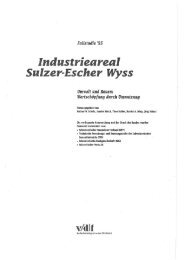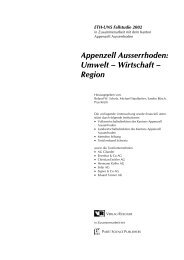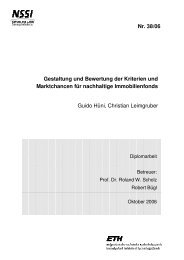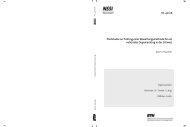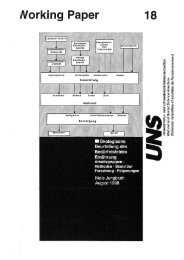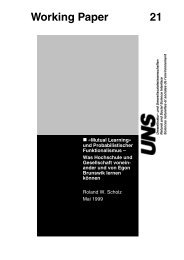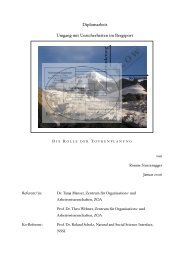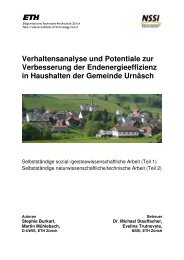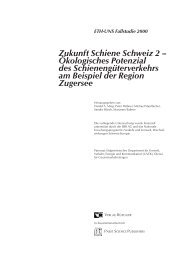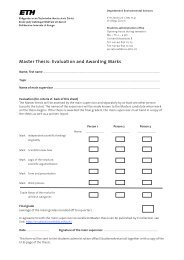The Paradigm of Human-Environment Systems - Natural and Social ...
The Paradigm of Human-Environment Systems - Natural and Social ...
The Paradigm of Human-Environment Systems - Natural and Social ...
You also want an ePaper? Increase the reach of your titles
YUMPU automatically turns print PDFs into web optimized ePapers that Google loves.
<strong>The</strong> <strong>Paradigm</strong> <strong>of</strong> <strong>Human</strong>-<strong>Environment</strong> <strong>Systems</strong><br />
Table 2 provides a brief definition, examples, <strong>and</strong> some regulatory mechanisms that are<br />
essential in shaping the human-environment interaction for each hierarchical level. At each<br />
hierarchical level, the regulatory mechanisms refer to the elements <strong>and</strong> relations presented in<br />
Figure 1. Conceptualizing the regulatory mechanisms is considered the most important part <strong>of</strong><br />
HES research. In this paper we only deal with two issues, which might be uncommon to the<br />
environmental scientist: (i) <strong>The</strong> role <strong>of</strong> concepts as a crucial unit in regulation from the individual<br />
level to the societal level; <strong>and</strong> (ii) the role <strong>of</strong> institutions <strong>and</strong> institutionalization.<br />
Concepts are the building blocks <strong>of</strong> cognition <strong>and</strong> an efficient means <strong>of</strong> reducing com-<br />
plexity. Concepts such as “miasma”, “resilient”, “no risk”, “safe”, or “sustainable” produce categorizations<br />
<strong>and</strong> may function as attractors in goal formation <strong>and</strong> strategy selection. For example,<br />
risk can be seen as a specific evaluative function in strategy selection 2 at all hierarchical<br />
levels (at least) starting at the individual. Risk combines the evaluation <strong>of</strong> the probability <strong>and</strong><br />
the outcomes <strong>of</strong> uncertain events, which are linked to action alternatives, Ai . In answering the<br />
question which risks are acceptable, western society has implicitly agreed to accept the new<br />
environmental or technological risks to which people are exposed, if the mortality rate is less<br />
than 1/100,000 (Wilde, 1994). However, both society <strong>and</strong> individuals differ largely. Fischh<strong>of</strong>f et<br />
al. (1979) have shown that risks from voluntary activities tend to be judged lower <strong>and</strong> are thus<br />
more likely to be accepted. Thus the mortality rate <strong>of</strong> car accidents is about 10/100,000 <strong>and</strong> <strong>of</strong><br />
smoking 300/100,000 (CDC, 1999). <strong>The</strong>se mortality rates <strong>and</strong> the question which risk is acceptable<br />
are matters <strong>of</strong> dispute <strong>and</strong> measures both on <strong>and</strong> between many levels <strong>of</strong> human systems.<br />
For example, an individual has to trade<strong>of</strong>f the benefits <strong>and</strong> the potential harms <strong>of</strong> smoking.<br />
However, the fact that he/she smokes also has an impact on the levels <strong>of</strong> his/her peer group,<br />
health insurance, <strong>and</strong> society.<br />
Society per se has larger time scales than lower hierarchical levels, e.g. organizations, or<br />
individuals. Society has the specific task <strong>of</strong> managing environmental dynamics <strong>and</strong> establishing<br />
secondary feedback loops (monitoring systems) to secure its own future (i.e., quantity <strong>and</strong><br />
quality <strong>of</strong> resources). Institutions provide a structure by which society can fulfill these goals.<br />
<strong>The</strong>y give the boundary conditions for strategy selection at all hierarchical levels. Institutionalization<br />
itself takes place in a secondary feedback loop.<br />
2 Note that the risk concept <strong>and</strong> risk management can be traced back 5.000 years to the Mesopotamians (Oppenheim,<br />
1977). According to Slovic, Fischh<strong>of</strong>f, <strong>and</strong> Lichtenstein (2000), risk has a kind <strong>of</strong> personality. Obviously, decision<br />
makers are not only taking the statistical data into account, but are rather strongly influenced by their own<br />
interpretation <strong>of</strong> the situation characteristics. For instance, air travel is judged more risky than travel by car though<br />
it is much safer on a per mile basis. This clearly is due to the uncontrollability <strong>of</strong> air travel by passengers <strong>and</strong> the<br />
cognitive salience <strong>of</strong> spectacular accidents (see Nisbett & Ross, 1980).<br />
ETH-UNS Working Paper 37 9



